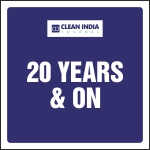 Three of the five thrust areas of the Amrut Mission concern water and wastewater are the enhancement of water supply and sewerage connections for every citizen; sewerage treatment facilities and septage management; as well as storm drainage systems. The programme commenced in June 2015. Furthermore, thirdly, there is the Smart cities initiative (formerly Jawaharlal Nehru National Urban Renewal Mission) which requires cities applying for funding to come up with sanitation and solid waste management plans. In early 2016, the first 20 cities were selected under this scheme. Finally, the National Mission on Clean Ganga finances WWTP and municipal sewage treatment as well;six new plants were commissioned under the scheme along the Ganga in 2014. However, despite these renewed efforts to clean the Ganga, local experts are sceptical about its effect since similar missions have been in place since the 1970s with very limited results.
Three of the five thrust areas of the Amrut Mission concern water and wastewater are the enhancement of water supply and sewerage connections for every citizen; sewerage treatment facilities and septage management; as well as storm drainage systems. The programme commenced in June 2015. Furthermore, thirdly, there is the Smart cities initiative (formerly Jawaharlal Nehru National Urban Renewal Mission) which requires cities applying for funding to come up with sanitation and solid waste management plans. In early 2016, the first 20 cities were selected under this scheme. Finally, the National Mission on Clean Ganga finances WWTP and municipal sewage treatment as well;six new plants were commissioned under the scheme along the Ganga in 2014. However, despite these renewed efforts to clean the Ganga, local experts are sceptical about its effect since similar missions have been in place since the 1970s with very limited results.
The Modi government is pushing for a more participatory, peoplecentred approach, talking about ‘people-public-private-partnerships’. In some states and municipalities, this may clash with local political preferences on privatization of water and wastewater. Water supply has been the political priority for decades and still pervades in the mindset of many policymakers and bureaucrats. Freshwater provision at low or no cost is often a campaigning issue, for instance in the latest Delhi elections. Under the Modi government, sewage and septage are now receiving more attention, indicating a possible shift in mindset. In some areas such as Kochi, sewage receives as much attention as water supply, especially since plenty freshwater is available. Recycling and reuse of wastewater is neither a political priority at federal level nor at state or municipal level yet, in spite of the federal policy goal of 20% reuse. It only takes place when water scarcity leaves no other option.
Overall, energy comes into wastewater planning primarily as a cost factor. No systematic, integrated planning of water and energy is yet taking place. Water is reused in agriculture (treated and untreated), partly in horticulture, and in some industries for cooling, especially in water-scarce cities. In some periurban areas of India, sludge generated by WWTPs is used by farmers as well. There is no specific regulation for sludge discharge yet; most utilities still see it as a mere nuisance. Regulation for a national feed-in tariff for renewable energies exist that needs state-level adjustments and implementation.
There are generally no taxes for water or sewage services. Water tariffs are usually set by the urban local bodies and utilities. Most interview partners agreed that technologies in the sector are generally available and that finances are not much of an issue due to the various national missions and various programmes offered by donor agencies. Usually, central and state governments share the costs for sewage equally. The reasons why there is not more investment in the sector vary from city to city.
Extract from a report of Babette Never, a researcher at the German Development Institute in the department “Sustainable Economic and Social Development”, Bonn. This report is one component of a larger project on the “Water-Energy- Food-Nexus” carried out by the German Development Institute. (To be continued…)


































